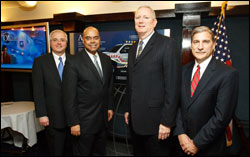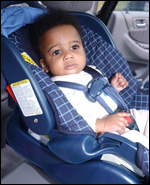CDC In the News
Partnership Seeks to Improve Crash Response
Published: June 5, 2007

Shown above (l-r): Richard Hunt, director, Division of Injury Response, National Center for Injury Prevention and Control; Rod Gillum, president, GM Foundation; Charles Stokes, president, CDC Foundation; and Chet Huber, president, OnStar.
After a serious traffic crash, every minute without proper medical care can mean the difference between life and death. GM/OnStar, CDC, and the CDC Foundation have partnered to improve emergency crash response.
CDC will convene a panel of more than 20 emergency medical physicians, trauma surgeons, public safety and vehicle safety experts to consider how real-time crash data from OnStar's Advanced Automatic Crash Notification (AACN) vehicle telematic system and similar systems from other companies can be used to determine whether occupants need care at a trauma center.
The panel meetings will be funded by a $250,000 grant from OnStar and the GM Foundation to the CDC Foundation. (As a federal agency, CDC does not promote or endorse specific products.)
"For more than 10 years, OnStar has been proud to work hand-in-hand with local medical and public safety communities to create tools to help reduce traffic fatalities and extend needed emergency care," said Chet Huber, president of OnStar. "We are extremely excited to partner with the CDC and the CDC Foundation in this ground-breaking initiative that has the potential to dramatically impact the lives of our subscribers and all drivers."

Photo by Annemarie Poyo
This 2004 photograph shows an infant who has been properly positioned, and buckled into a rear-facing infant-only car seat. For example, notice the harnesses are snug; the plastic harness clip is positioned at the armpit level in order to hold the shoulder straps in place; the straps are lying flat; the baby is dressed in clothes that allow the strap to go between the legs; and the child is not slouching down, or to the side.
In 2005, Americans were involved in more than 6 million police-reported traffic crashes, in which more than 40,000 people were killed and more than 2 million people were injured.
Using a collection of sensors, vehicle telemetry systems like OnStar send crash data to an advisor if the vehicle is involved in a moderate or severe front, rear or side-impact crash. Depending on the type of system, the data includes crash severity information, along with data on the direction of impact, air bag deployment, multiple impacts, and a rollover (if equipped with appropriate sensors). Advisors can relay this information to emergency dispatchers helping them to quickly determine the appropriate combination of emergency personnel, equipment, and medical facilities needed.
"Providing emergency responders with vehicle crash information may help them make the appropriate field triage decisions, so crash victims can get to the right type of healthcare facility at the right time," said Richard Hunt, MD, director of CDC's Injury Center's Division of Injury Response.
He adds, "CDC-supported research has shown that care at a Level I trauma center lowers the risk of death by 25 percent for severely injured patients compared with treatment received at a non-Level I trauma center. We look forward to working with the expert panel in cooperation with the National Highway Traffic and Safety Administration to better understand how to use this technology to help the emergency medical community save lives."
"Time is a critical factor in trauma care," said David Cone, MD, president of the National Association of EMS Physicians. "The goal is to develop evidence-based protocols that will allow the emergency medical community to effectively use automotive telemetry data to assist in reducing morbidity and mortality through faster patient identification, diagnosis, and treatment."
For more, visit the GM News website.
Content source: Centers for Disease Control and Prevention
